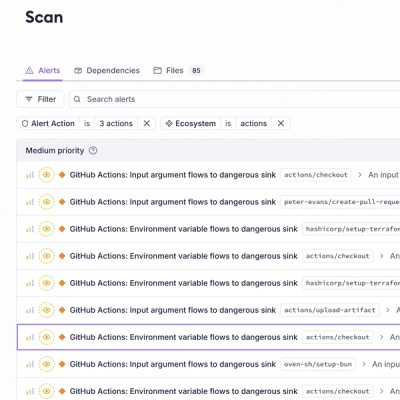
Product
Introducing Socket Firewall Enterprise: Flexible, Configurable Protection for Modern Package Ecosystems
Socket Firewall Enterprise is now available with flexible deployment, configurable policies, and expanded language support.
Epoxy is a tool to glue cloud services together. Conceptually it's similar to Zapier.
Currently the only supported use case is to sync a Contentful environment with a Google Cloud Storage bucket. Other use cases may be implemented as the need arises.
usage: epoxy <command>
Commands:
epoxy deploy deploy to local or cloud
epoxy log get logs from local instance
epoxy transfer-all initiate a transfer of all resources
Options:
--version Show version number [boolean]
-h, --help Show help [boolean]
In typical usage, you would create an index.js file that will require epoxy and pass it the configuration it requires.
const {join} = require('path')
// load environment variables
require('env-yml').config({path: join(__dirname, 'env.dev.yml')})
const {
SERVICE_URL,
CONTENTFUL_SPACE_ID,
CONTENTFUL_ENVIRONMENT,
CONTENTFUL_MANAGEMENT_TOKEN,
CONTENTFUL_TOKEN,
GCLOUD_PROJECT,
GCLOUD_BUCKET,
GCLOUD_PATH_PREFIX,
} = process.env
const resource_config = require('../config/resources.json')
// initialize epoxy
const epoxy = require('epoxy')
const services = epoxy({
contentful: {
space_id: CONTENTFUL_SPACE_ID,
environment: CONTENTFUL_ENVIRONMENT,
management_token: CONTENTFUL_MANAGEMENT_TOKEN,
token: CONTENTFUL_TOKEN,
},
gcloud: {
project: GCLOUD_PROJECT,
bucket: GCLOUD_BUCKET,
path_prefix: GCLOUD_PATH_PREFIX,
auth_file: join(__dirname, '../config/gcloud-auth.json'),
},
service_url: SERVICE_URL,
resource_config,
})
// services must be returned as exports in order for google cloud
// functions to process and upload
module.exports = services
To obtain a gcloud-auth.json, follow the directions for setting up a google service account, and make sure that service account has write access to the bucket you intend to deploy to.
Your resource config will depend on the contentful resources that you want to sync up. It will look something like this:
{
"resources": {
"category": {
"params": {
"path": "category",
"fileNameKey": [ "id" ]
},
"actions": {
"publish": [
{
"$service": "writeEntry"
}
],
"unpublish": [
{
"$service": "deleteEntry"
}
]
}
},
"topics": {
"params": {
"path": "topic",
"fileNameKey": [
"category",
"id"
]
},
"actions": {
"publish": [
{
"$service": "writeEntry"
}
],
"unpublish": [
{
"$service": "deleteEntry"
}
]
}
}
}
}
These are the standard services that are supplied. Think of them as the possible "outputs" of your pipeline.
Simple params:
"params": {
"path": "category",
"fileNameKey": [ "id" ]
},
This will pull id out of the data coming in from contentful and use that as the filename.
fileNameKey supports some more complex use cases as well:
"params": {
"path": "topics",
"fileNameKey": [
"id",
{
"md5": [ "content" ]
}
]
},
This will take the id from the data, run an md5 function on the content, and join the result with an underscore. The result might look like topics/5_a94e2.
In addition you can define your own services and pass them to epoxy at the time of initialization.
const services = epoxy({
...other config,
custom_services: require('./custom')
})
custom_services should be an object where the keys are service names, and the values are in the format of a standard law service.
Custom services let you perform any action you want - save to a database, send a request to a cloud service, etc. Any javascript code you want to write can be run and passed the params of the event. If you build some general purpose services that you think others might find handy, let us know! We'd love to expand our library of features.
Before March 11, 2019 and version 1.0.0, epoxy was a templating library. If this is your use case, please fix your version number to 0.4.1. Be aware that this use case has been deprecated and will no longer be supported.
FAQs
Sync a headless CMS with a cloud storage bucket.
The npm package epoxy receives a total of 0 weekly downloads. As such, epoxy popularity was classified as not popular.
We found that epoxy demonstrated a not healthy version release cadence and project activity because the last version was released a year ago. It has 1 open source maintainer collaborating on the project.
Did you know?

Socket for GitHub automatically highlights issues in each pull request and monitors the health of all your open source dependencies. Discover the contents of your packages and block harmful activity before you install or update your dependencies.

Product
Socket Firewall Enterprise is now available with flexible deployment, configurable policies, and expanded language support.

Security News
Open source dashboard CNAPulse tracks CVE Numbering Authorities’ publishing activity, highlighting trends and transparency across the CVE ecosystem.

Product
Detect malware, unsafe data flows, and license issues in GitHub Actions with Socket’s new workflow scanning support.